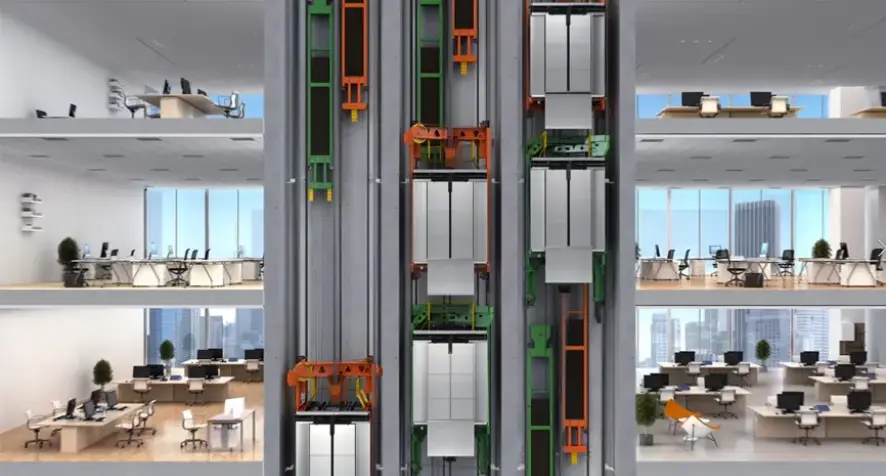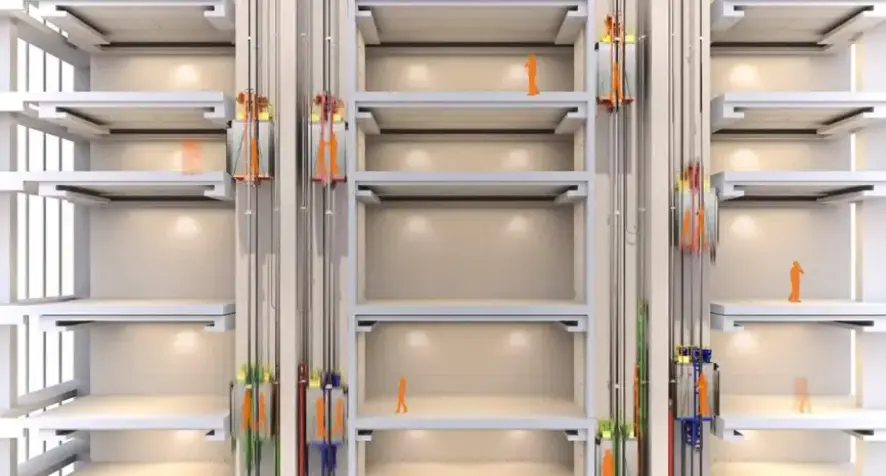Benefits of TWIN: Why You Need Two Elevators in One Shaft
In futuristic films, we have gotten a glimpse into what tomorrow might hold for technology. Many innovations that would’ve seemed unrealistic and implausible in the past have proven themselves to be trustworthy and credible investments in recent years.
TWIN is a fantastic progression in elevator technology. With two elevator cabins operating independently in one shaft (aka hoistway) — the possibilities are endless. Here you will learn a few key benefits of TWIN and why you need two elevators in one shaft.

Safety and Credibility of TWIN
Even for those that are in the elevator industry, there have been some doubts about how efficiently two cabins in one shaft can run. It’s imperative to fully comprehend the innerworkings of TWIN and what makes it such an outstanding invention.
TWIN is the first of its kind: two elevator cabs which function completely independent from one another while utilizing the same hoistway. Each of the cabs are controlled by their own respective equipment including counterweights, ropes, traction drives, controllers and governors. But while each cab has their own machinery, it’s important to keep in mind that they will still use the same landing doors and rails.
Since this new and exciting display of advanced engineering has debuted, its reliability has been recognized with a TÜV-tested safety certification to meet even the strictest specifications and requirements.
Better Building Flow and Less Traffic
The popular phrase “less is more” hits the mark when it comes to building traffic and wait times that commuters experience in the lobby before their elevator arrives.
Lower wait times, less traffic and fewer complaints inevitably lead to more happy tenants. As we discover the benefits of TWIN, one of the most notable advantages is the help it provides with the traffic flow patterns in your building.
If having two cabs for each hoistway wasn’t enough to prove its capability in moving passengers swiftly, TWIN also comes supplied with an intelligent Destination Dispatch Control system.
This system is a digital solution that groups passengers together based on their destination floor to guarantee lower wait times and less crowding in lobby areas. This not only increases traffic flow and allows tenants a quicker commute but can transport as many as 40% more passengers than other elevator systems.

Low Energy Consumption
One of the most distinctive qualities that sets TWIN apart from the rest is the incredible amount of energy that it saves. One of the cabs can be parked as the other cab remains in operation during non-peak hours — this can significantly reduce the amount of energy used.
For example, if an office building is less busy on the weekends and largely void of its 9-to-5 commuter population, the elevator control system will set commands for one cab to stay stationary while the other carries passengers to their destination.
TWIN also has the option to enable an energy recovery function to feed about 30% of its energy generated through braking back into your building’s power grid. This regenerative drive will only further help decrease energy consumption.
Move More Passengers with Less Space
Mentioned previously, the two-in-one design was primarily made with traffic flow improvement in mind. As the arrangement eases up lobby congestion, it still manages to increase your building’s space at the same time with its clever configuration.
Having two cabs ensures that you’ll be able to transport twice as many passengers without needing to leave extra space for the other hoistways that would normally be required.
The number of shafts that you’ll have for your building can practically be cut in half with TWIN. You will save money and time by keeping more of your building’s leasable space while lowering construction costs. This becomes extremely important if the building was originally built with a lower population requirement. Instantly, you can move twice as many people so the building can accommodate a higher building population.
All these positive factors mixed with the reduction of labor and material expenses can easily explain why you need two elevators in one shaft.
If you’d like to learn more about TWIN, please don’t hesitate to contact us.
 United States
United States

